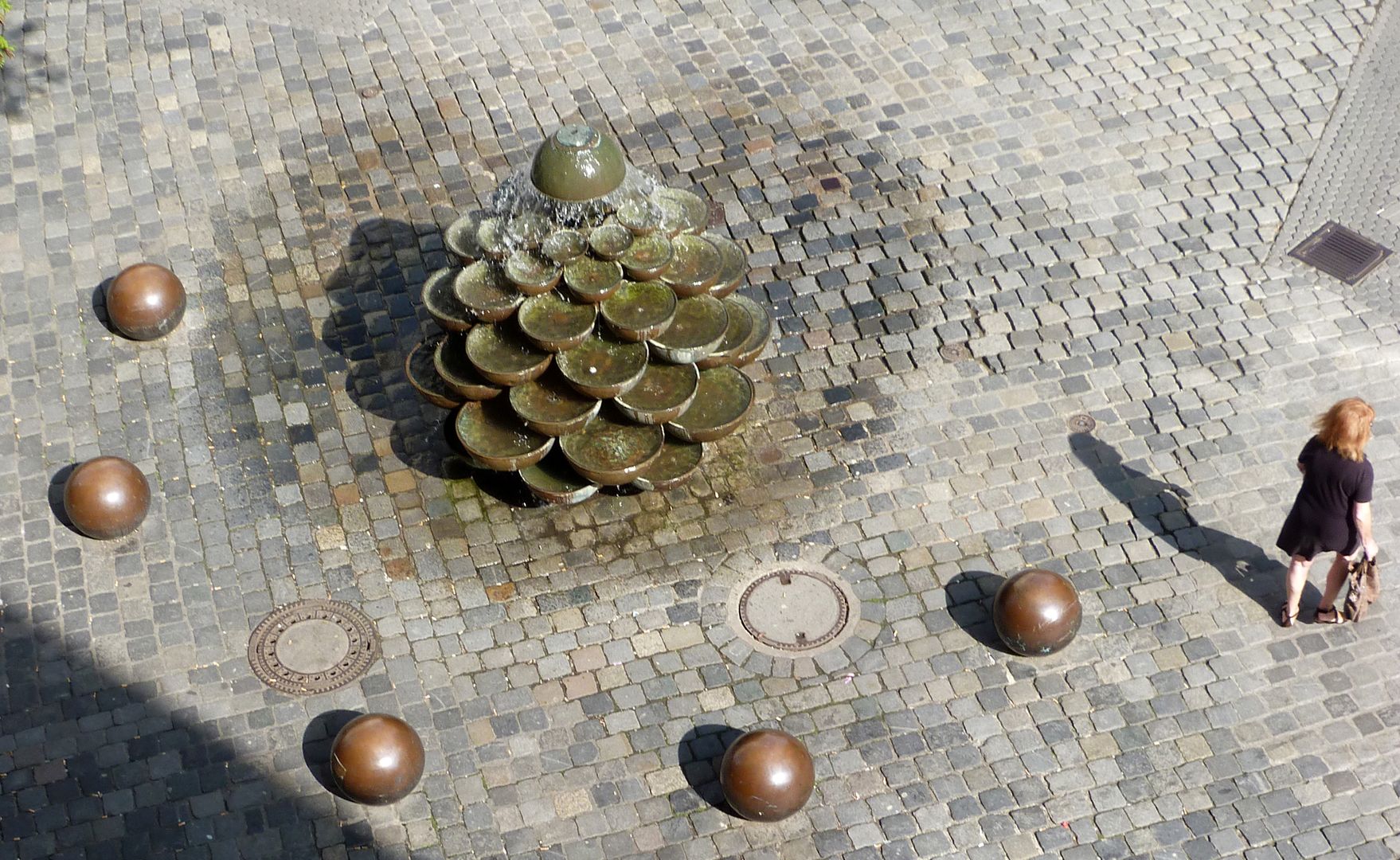little bowles´fountain
little bowles´fountain
1977
View towards Fleischbrücke
Bowl cascade fountain
originally surrounded by 7 bronze spheres
The shape of the 60 geometrically staggered bowls is reminiscent of a pine cone.
pine cone.
"The pine cone can be traced back to Assyrian art. The ancient world used it as a gargoyle as early as the 2nd century BC. (...) Because of its many scales, it was considered a symbol of fertility and of life in general (as in the cult of Mithras), and therefore it also appears in Christian art as the crowning of the fountain of life."
(Dictionary of Art / Johannes Hahn / Alfred Kröner Verlag Stuttgart, 1989)
Location: Nuremberg, Kaiserstrasse corner Fleischbrücke
Design: Lederer, Helmut
Realization: Lederer, Helmut
Material: 60 copper bowles
photo 2013, Theo Noll
little bowles´fountain
1977
View towards Königstraße
Bowl cascade fountain
originally surrounded by 7 bronze spheres
The shape of the 60 geometrically staggered bowls is reminiscent of a pine cone.
pine cone.
"The pine cone can be traced back to Assyrian art. The ancient world used it as a gargoyle as early as the 2nd century BC. (...) Because of its many scales, it was considered a symbol of fertility and of life in general (as in the cult of Mithras), and therefore it also appears in Christian art as the crowning of the fountain of life."
(Dictionary of Art / Johannes Hahn / Alfred Kröner Verlag Stuttgart, 1989)
Location: Nuremberg, Kaiserstrasse corner Fleischbrücke
Design: Lederer, Helmut
Realization: Lederer, Helmut
Material: 60 copper bowles
photo 2012, Theo Noll
little bowles´fountain
1977
Bowl cascade fountain
originally surrounded by 7 bronze spheres
The shape of the 60 geometrically staggered bowls is reminiscent of a pine cone.
pine cone.
"The pine cone can be traced back to Assyrian art. The ancient world used it as a gargoyle as early as the 2nd century BC. (...) Because of its many scales, it was considered a symbol of fertility and of life in general (as in the cult of Mithras), and therefore it also appears in Christian art as the crowning of the fountain of life."
(Dictionary of Art / Johannes Hahn / Alfred Kröner Verlag Stuttgart, 1989)
Location: Nuremberg, Kaiserstrasse corner Fleischbrücke
Design: Lederer, Helmut
Realization: Lederer, Helmut
Material: 60 copper bowles
photo 2018, Theo Noll
little bowles´fountain
1977
View from above, towards Fleischbrücke
Bowl cascade fountain
originally surrounded by 7 bronze spheres
The shape of the 60 geometrically staggered bowls is reminiscent of a pine cone.
pine cone.
"The pine cone can be traced back to Assyrian art. The ancient world used it as a gargoyle as early as the 2nd century BC. (...) Because of its many scales, it was considered a symbol of fertility and of life in general (as in the cult of Mithras), and therefore it also appears in Christian art as the crowning of the fountain of life."
(Dictionary of Art / Johannes Hahn / Alfred Kröner Verlag Stuttgart, 1989)
Location: Nuremberg, Kaiserstrasse corner Fleischbrücke
Design: Lederer, Helmut
Realization: Lederer, Helmut
Material: 60 copper bowles
photo 2013, Theo Noll
little bowles´fountain
1977
View from above
Bowl cascade fountain
originally surrounded by 7 bronze spheres
The shape of the 60 geometrically staggered bowls is reminiscent of a pine cone.
pine cone.
"The pine cone can be traced back to Assyrian art. The ancient world used it as a gargoyle as early as the 2nd century BC. (...) Because of its many scales, it was considered a symbol of fertility and of life in general (as in the cult of Mithras), and therefore it also appears in Christian art as the crowning of the fountain of life."
(Dictionary of Art / Johannes Hahn / Alfred Kröner Verlag Stuttgart, 1989)
Location: Nuremberg, Kaiserstrasse corner Fleischbrücke
Design: Lederer, Helmut
Realization: Lederer, Helmut
Material: 60 copper bowles
photo 2013, Theo Noll
little bowles´fountain
1977
Detail with the upper bowls
Bowl cascade fountain
originally surrounded by 7 bronze spheres
The shape of the 60 geometrically staggered bowls is reminiscent of a pine cone.
pine cone.
"The pine cone can be traced back to Assyrian art. The ancient world used it as a gargoyle as early as the 2nd century BC. (...) Because of its many scales, it was considered a symbol of fertility and of life in general (as in the cult of Mithras), and therefore it also appears in Christian art as the crowning of the fountain of life."
(Dictionary of Art / Johannes Hahn / Alfred Kröner Verlag Stuttgart, 1989)
Location: Nuremberg, Kaiserstrasse corner Fleischbrücke
Design: Lederer, Helmut
Realization: Lederer, Helmut
Material: 60 copper bowles
photo 2013, Theo Noll







